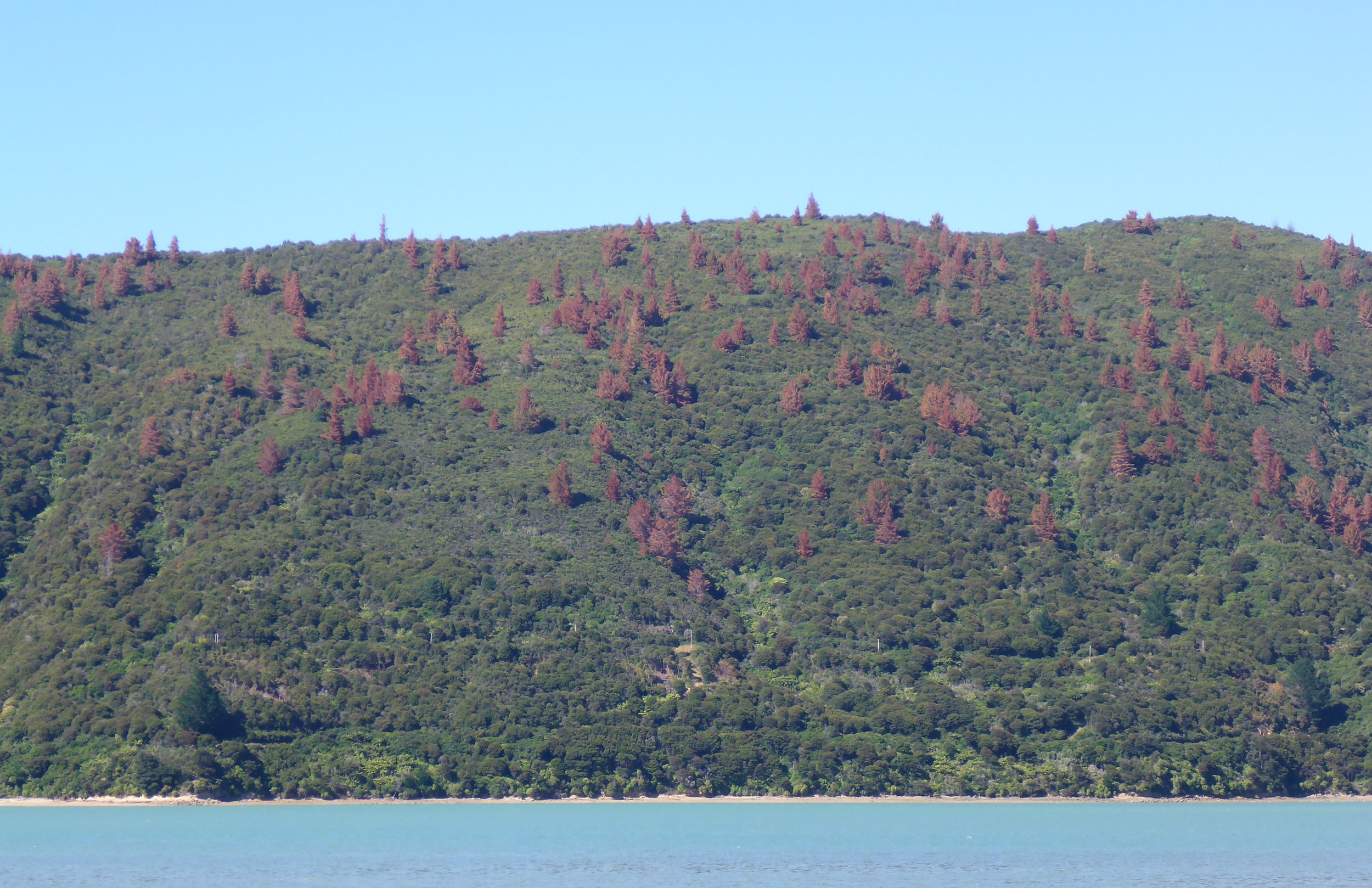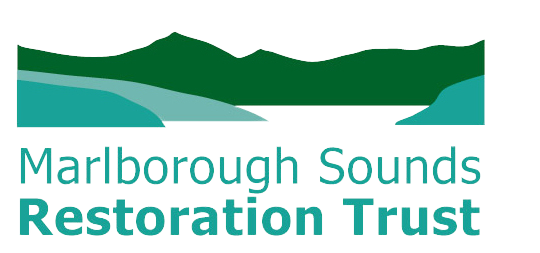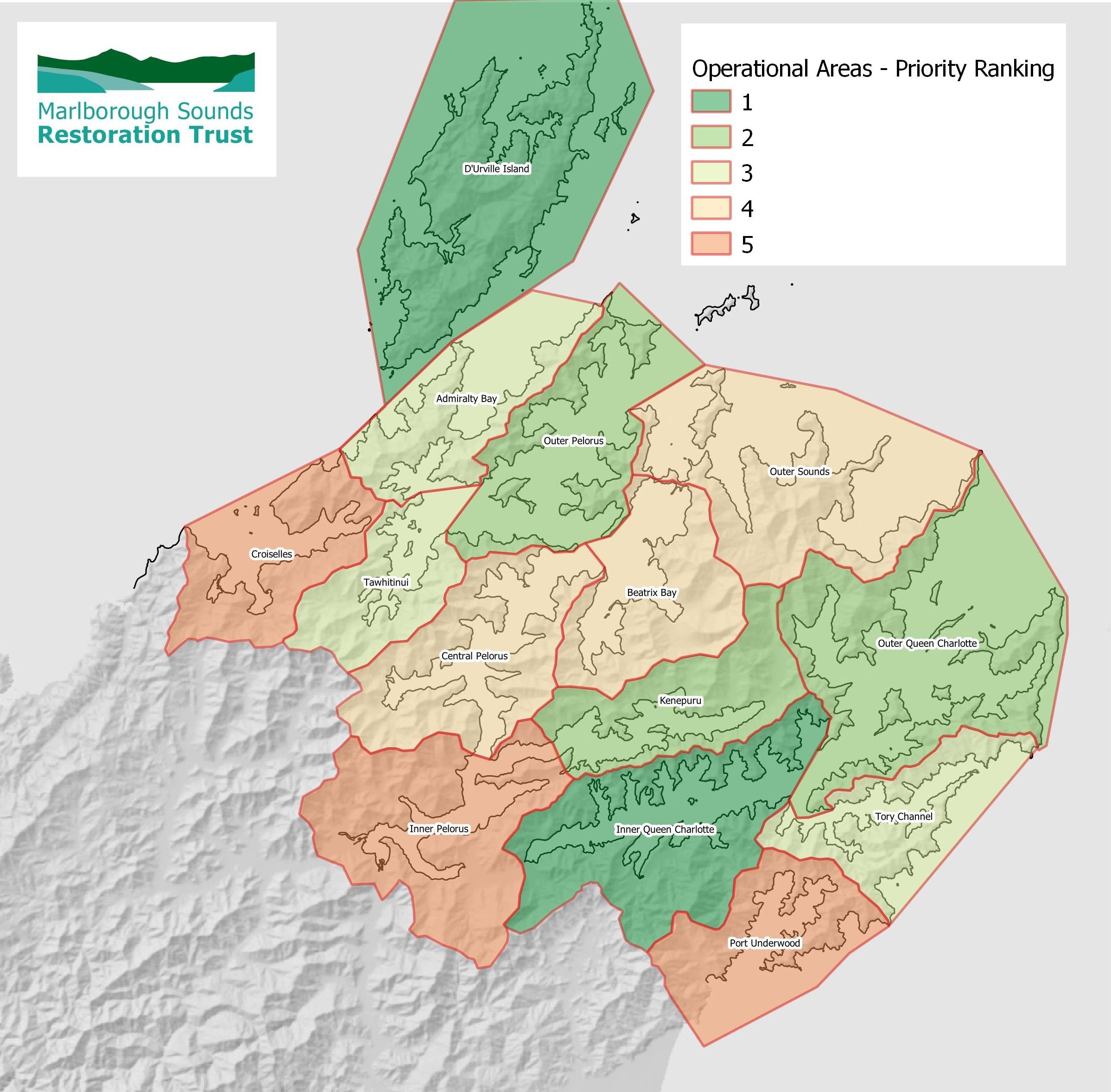
The Trust's flagship programme is the control of wilding pines throughout the Marlborough Sounds
What Are Wilding Pines?
Wilding Pines In The Sounds
Wilding pines ruin the Sounds landscape and threaten native forest regeneration. In some parts of the Sounds, wilding pines are overtaking native plants as the dominant species. Thick stands of pines present a major fire risk and can also reduce catchment water flows.
For the first time, through the Trust’s activities, a strategic and planned approach to wilding pine control is being undertaken in the Sounds and on a scale far larger than any work done previously.
Where Are We Working?
The Trust is taking a strategic and staged approach to wilding pine control in the Marlborough Sounds.
The Sounds has been divided into fourteen management sectors, and each sector has been prioritised for control.
Work is underway in eight of the management sectors:
D’Urville Island & Inner Queen Charlotte (Priority 1)
Kenepuru, Outer Queen Charlotte & Outer Pelorus (Priority 2)
Tory Channel, Admiralty Bay & Tawhitinui (Priority 3).
The Trust also gets involved in occasional projects outside these management sectors, where landowners and resident groups are seeking assistance to deliver wilding pine control in their corner of the Sounds.
-
-
Wilding pines are a significant problem in the Sounds, undermining its scenic qualities and threatening the natural environment.
The most obvious impact is the loss of scenic values, as wilding pines establish above the regenerating native forest canopy and, in many areas, become the dominant feature of the skyline. A Trust report concluded that, without wilding pine control, the landscape values of the Sounds will gradually diminish. It will lose its distinctiveness, and very special identity based on its natural qualities.
Wilding pines also have dramatic ecological impacts. The fast growth rates of wilding pines allow them to out-compete and suppress low-stature native vegetation, such as coastal plant communities. In extreme situations, the uncontrolled spread of wilding pines could lead to the local extinction of some plant communities.
Wilding pines can also have an impact on native fauna, particularly lizards and invertebrates. A Trust report noted that there are many close associations between native plants and native invertebrates, such that invertebrates would be displaced if wilding pines suppressed native coastal vegetation, shrubland and regenerating forest. Similarly, displacement of native shrubland and regenerating forest by wilding pines is likely to impact on native lizards, which feed on nectar, fruit and invertebrates. A Department of Conservation report also notes that, in general, fewer native bird species are found in conifer forests than in native forests.
Wilding pines are also likely to affect freshwater communities, as pine forests lower catchment flows as compared to either native forest or pasture. These reduced catchment flows could have significant implications on in-stream flora and fauna.
-
In 2007, the Trust decided to set up a comprehensive, community-led wilding pine programme, to complement existing control efforts. For years, private landowners and the Department of Conservation had been undertaking small wilding pine control projects, but without sufficient size and scope to address the problem over the Sounds as a whole. The Trust aimed to establish a co-ordinated programme that tackled pine control in a strategic way, dividing its management areas into control blocks, based on the extent of wilding pine infestation, access considerations, tenure, land use and landscape values, and working through these in order of priority.
-
Professional contractors are engaged to underake the control work. Seedlings and young trees are either hand-pulled or felled using a pruning saw. Mature trees are generally poisoned by injecting holes into their trunks, and injecting a small amount of herbicide into each hole. The active ingredient is usually either glyphosate or metsulfuron-methyl, which are common agricultural herbicides. This method is environmentally-friendly, with no discharge of herbicide to land, waterways or the air. Occasionally, trees in difficult-to-access areas, or where they are widely spaced, will be treated from helicopter by herbicide application onto the bark of the trees.
-
Poisoned trees are left standing. Initially each tree turns brown and lose its needles, during which time it will be very obvious visually. Eventually, it will become a dead spar in the forest that will rot away, with its branches and stem slowly falling to the ground in pieces, over a period of up to 15 years for large trees.
-
The felling of wilding pines has been tried in the Sounds in the past. However, it can make the wilding pine problem worse. Large trees break down a lot of regenerating native vegetation as they hit the ground, thereby opening up a 'light well' on the forest floor. Pine seeds like high light conditions to germinate, and dozens of seedlings can appear around the felled tree.
By contrast, poisoning leaves the surrounding regenerating native vegetation undisturbed, and allows a seamless transition from wilding pines to native vegetation. Significantly less secondary pine re-growth is anticipated from poisoning.
It is widely recognised as the preferred means of managing wilding pines in forested areas.
-
While the killing of trees standing is the preferred control method, contractors generally exclude trees that are close to powerlines, baches, foreshore structures, public roads and the coastline.
These trees will generally be left, and remain the responsibility of the relevant land owner. The Trust may, however, have some felled by a qualified chainsaw operator as a follow-up to the poisoning operation.
-
Access to private land is at the landowner’s discretion. The Trust programme is a voluntary and community-led one, and will only work on private land where the landowner has provided access consent to the Trust.
Advice for Landowners
The Trust encourages and supports landowners to undertake their own small-scale wilding pine control, as a complement to its own programme.
A comprehensive document that provides guidance on converting pine plantations to native forest has been produced by the Trust, DOC and the Marlborough District Council, and is available here.
Additional information on control methods is available below:


